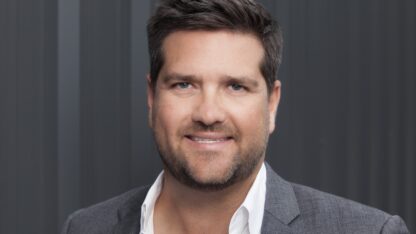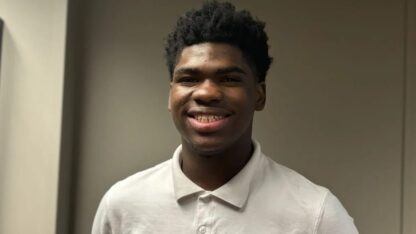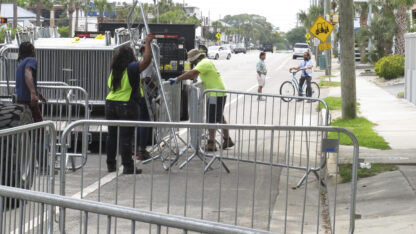John Lewis, Congressman And Civil Rights Icon, Has Died

Rep. John Lewis has died at the age of 80.
Mark Humphrey / Associated Press
John Robert Lewis, a leader of the civil rights movement and longtime U.S. congressman from Atlanta, has died at the age of 80, after a battle with pancreatic cancer. He is survived by his son, John Miles Lewis, with his wife of more than 40 years, the late Lillian Lewis, who died in 2012.
Lewis grew up as the son of sharecroppers outside of Troy, Alabama, and became inspired by civil rights icons Rev. Martin Luther King Jr. and Rosa Parks to join the nonviolent protest movement. He carried that experience into a 17-term career in the U.S. House of Representatives, where he became known as the “conscience of the Congress.”
“When I was growing up, my mother and my father, my grandparents, my great-grandparents always told us, ‘Don’t get in the way. Don’t get in trouble,’” he said in a 2006 interview with Public Broadcasting Atlanta.
“But I was deeply inspired to get in the way. And I got in trouble. It was good trouble. Necessary trouble. People must find a way to get in the way and find a way to get in trouble.”
The concept of “good trouble” became a lifelong motto for Lewis as a protest leader and politician.
In 2015 he was awarded the country’s highest civilian honor, the Presidential Medal of Freedom for his life’s work, and in 2018 he received Atlanta’s highest honor, the Phoenix Award, at the same time John Lewis Freedom Parkway was renamed for him.
Civil Rights Icon
The last surviving speaker at the 1963 March on Washington and one of the “Big Six” leaders of the civil rights movement, Lewis served as chairman of the Student Nonviolent Coordinating Committee between 1963 and 1966. He challenged segregation through sit-in demonstrations and Freedom Rides despite beatings and arrests. Lewis was arrested more than 40 times over his life.
He led, with fellow civil rights activist Hosea Williams, a march for voting rights and integration in Alabama across the Edmund Pettus Bridge as they were leaving Selma for Montgomery in 1965. It became known as “Bloody Sunday” as hundreds of marchers were beaten and gassed by Alabama state troopers and law enforcement, including Lewis, who suffered a fractured skull. Fifty-eight people ended up in the local hospital.
The violence that day spurred the passage of the Voting Rights Act of 1965, months later.
Lewis recalled in the 2006 interview how it felt to re-enact that march in 2000 with President Bill Clinton. Then-governor of Alabama, Don Siegelman greeted the marchers on the other side of the bridge.
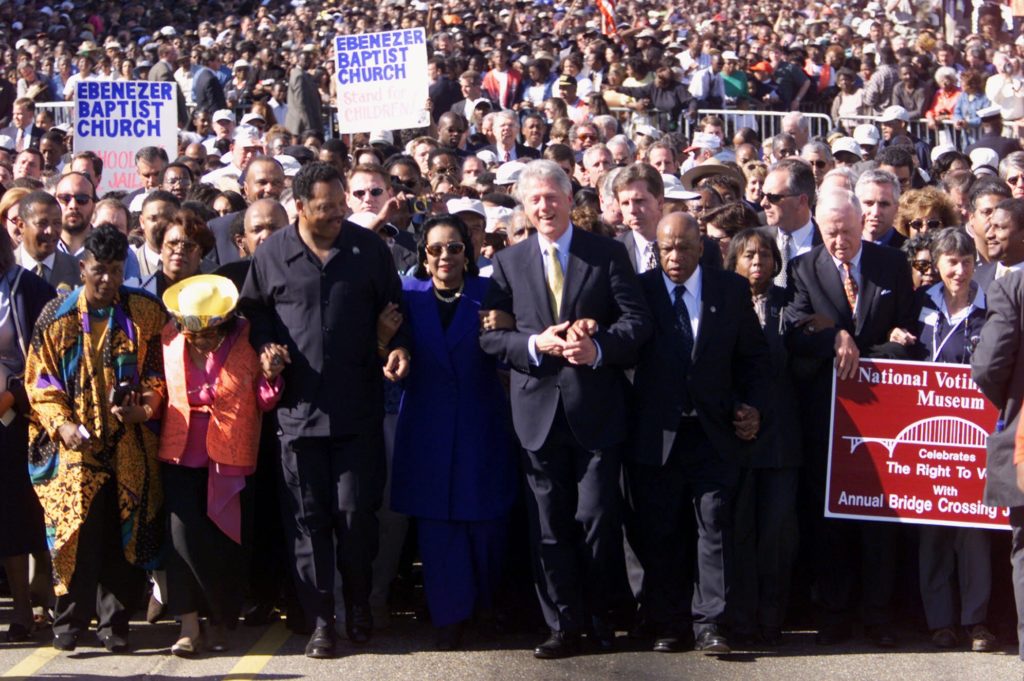
“[Siegelman] reached out his hand and said, ‘Welcome home, John Lewis. Welcome home.’ And he started crying. And the president [Clinton] cried, and I cried,” Lewis said.
“It’s a different world. And sometimes I hear people say, ‘Nothing has changed.’ And I feel like saying, ‘Come walk in my shoes. I’ll show you. It’s a different world.’”
‘Boy Preacher’
Lewis grew up on a farm in segregated Alabama with nine siblings and wanted to be a minister. He has said his teachers and fellow students called him the “boy preacher.”
Lewis refused to ignore the segregation he faced in his community, where he was denied a public library card and his parents were denied the right to vote.
“I would ask my mother and ask my father, ‘Why segregation? Why racial discrimination?’ And they would say, ‘That’s the way it is. That’s the way it is. Don’t get in trouble. Don’t get in the way.’”
But Lewis didn’t heed that advice.
“I was so inspired by Rosa Parks in 1955. I was 15 years old. I was inspired by Martin Luther King Jr. I heard his words on an old radio. And it seemed like he was saying to me, ‘John Lewis, you too can make a contribution,’” Lewis said on NPR’s Fresh Air in 2016.
“[King] was speaking at a church in Montgomery. And he was saying in effect, that we must not just be concerned about the pearly gates and the streets with milk and honey,” Lewis said. “We have to be concerned about the streets of Montgomery and the doors of Woolworth’s.”
‘Standing Up’
After trying unsuccessfully to attend a nearly all-white Troy State College, Lewis ended up attending American Baptist Theological Seminary and later Fisk University in Nashville, Tennessee.
Lewis wrote to King about his attempt to attend Troy State College and asked for help. King responded with a round-trip bus ticket to bring Lewis to Montgomery, which began their relationship. Lewis attended nonviolent resistance workshops and participated in “sit-in” demonstrations to desegregate businesses in Nashville and around the Southeast.

“It was there that by sitting down, I think we were really standing up,” he said in a 2004 interview with the American Academy of Achievement. “I saw many of us, and I know in my own case, I grew up while I was sitting on a lunch counter stool. I became a different person.”
“I just felt we were involved in something that was so large, so necessary, so right,” he said. “It was almost holy. There was something very righteous and something very pure about it.”
‘John Lewis School of Politics’
Following the height of the movement, Lewis entered politics as an Atlanta City Council member in 1981. After his election to represent the 5th Congressional District in Atlanta in 1986, he became a constant in the Georgia Congressional delegation, elected 17 times and known as the “conscience of Congress.”
Many have pointed to Lewis’ public service as an inspiration for their own, including former President Obama and Georgia state Sen. Nikema Williams, who is also chair of the Georgia Democratic Party.
She called Lewis a friend and an inspiration. In a 2019 interview, she said she considers herself a student of the “John Lewis School of Politics.”
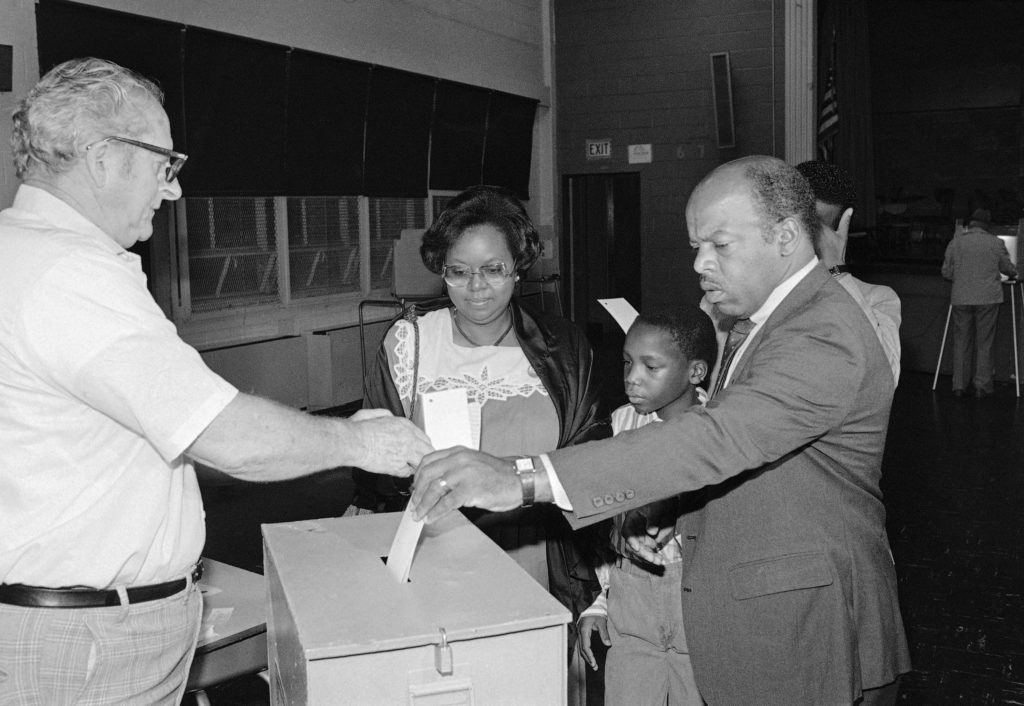
“I often find myself in trying times at the [Georgia] Legislature where it’s easy to stay in your seat, is easy to not speak up or speak out on certain issues because you want to make nice with your colleagues. But there are people counting on you,” she said.
“And it is our obligation as leaders to speak up and to speak out and to make sure that we are finding a way to get in the way. And that is that is good trouble…centering people that are most marginalized in your decision making and speaking up and speaking out even when it’s not comfortable to do so.”
Optimism
One of his largest policy legacies is the National Museum of African-American History and Culture on the National Mall. It was also one of his longest fights; he began championing the idea in 1988 and saw it to completion in 2016.
“People accuse me from time to time of being too hopeful, too optimistic,” Lewis said in the Academy of Achievement interview.
“But I think being hopeful, being optimistic is part of being a leader. That in a sense, you know where you’re going,” he said.
“I know maybe it won’t happen in my lifetime, but I know somehow, in some way, we’re going to create the beloved community. That we’re going to create a national community, a world community that is at peace.”





